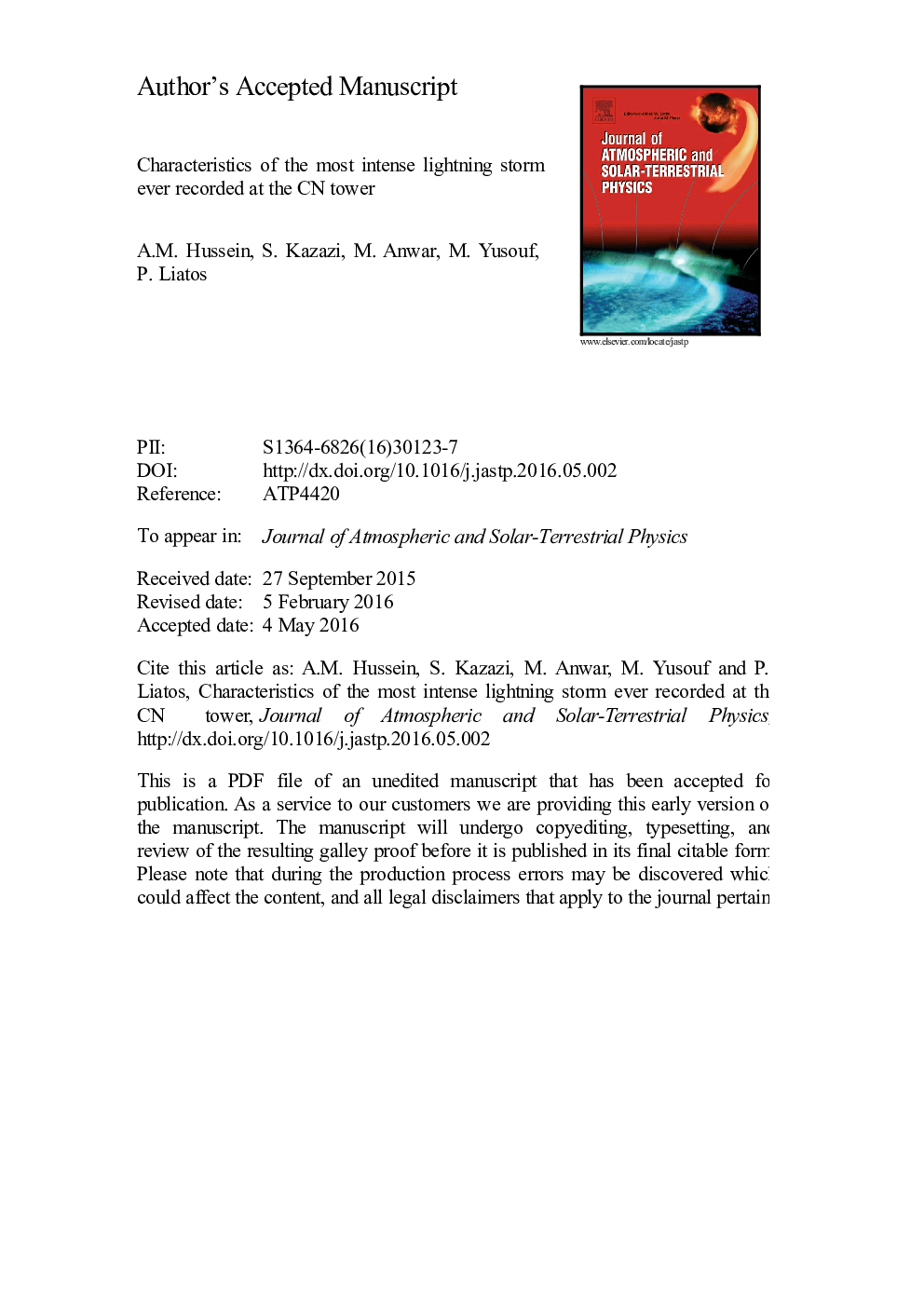| کد مقاله | کد نشریه | سال انتشار | مقاله انگلیسی | نسخه تمام متن |
|---|---|---|---|---|
| 5487617 | 1523595 | 2017 | 34 صفحه PDF | دانلود رایگان |
عنوان انگلیسی مقاله ISI
Characteristics of the most intense lightning storm ever recorded at the CN Tower
دانلود مقاله + سفارش ترجمه
دانلود مقاله ISI انگلیسی
رایگان برای ایرانیان
موضوعات مرتبط
مهندسی و علوم پایه
علوم زمین و سیارات
فیزیک زمین (ژئو فیزیک)
پیش نمایش صفحه اول مقاله

چکیده انگلیسی
Lightning strikes to the CN Tower have been optically observed since 1978. In 1990, five independent systems started to operate to simultaneously record parameters of lightning strikes to the tower, including the time derivative of the current, the associated electric and magnetic fields, and the channel optical characteristics. On August 24, 2011, during an unusually severe lightning storm, video records showed that the CN Tower was struck with 52 lightning flashes within 84Â min and 6.9Â s. Thus, this storm produced, on average, a flash to the tower every 99Â s. However, the CN Tower lightning current derivative measurement system only recorded 32 flashes, which were perfectly time-matched with 32 of the 52 video-recorded flashes. It is found that the current derivative measurement system recorded every video-recorded flash that contained at least one return stroke. Based on the analysis of video records, it is noted that each of the storm's 52 flashes contains an initial-stage current, proving that all flashes were upward initiated. This unique CN Tower storm - the most intense ever recorded at the tower - is here thoroughly analyzed, based on video and current records. The inter-flash time within the storm is found to vary between 10.6Â s and 274Â s, with an overall average of 98Â s. It is also found that the inter-flash time between successive non-return-stroke flashes is on average 64% longer than that for successive flashes containing return strokes. Statistical analysis of video and current data clearly reveals that the time duration of flashes containing initial-stage currents and return strokes is on average 27% longer than that of flashes that only have initial-stage currents. Furthermore, it is important to note that the time duration of the initial-stage current in flashes containing no return strokes is on average 76% longer than that in flashes containing return strokes. Therefore, it is possible to conclude that if the time duration of the initial-stage current in a flash is long enough, resulting in large charge transfer, then there is less probability of having return strokes following it. The 32 current-recorded flashes contain a total of 156 return strokes, with an average multiplicity of 4.875. It is worth mentioning that during one decade, 1992-2001, the CN Tower current derivative measurement system only recorded 478 return strokes, demonstrating that the number of return strokes recorded at the tower within about 84Â min is close to one third of those recorded at the tower during one decade. This finding clearly shows the great value and rarity of the presented extensive lightning current derivative data. Only one of the 32 current-recorded flashes is proved to be positive with a single return stroke. Based on current records, out of a total of 124 inter-stroke time intervals, 94% are found to be within 200Â ms, with an overall inter-stroke time average of 68.1Â ms. The maximum inter-stroke time recorded during this storm is 726.3Â ms, the longest ever recorded at the CN Tower.
ناشر
Database: Elsevier - ScienceDirect (ساینس دایرکت)
Journal: Journal of Atmospheric and Solar-Terrestrial Physics - Volume 154, February 2017, Pages 195-206
Journal: Journal of Atmospheric and Solar-Terrestrial Physics - Volume 154, February 2017, Pages 195-206
نویسندگان
A.M. Hussein, S. Kazazi, M. Anwar, M. Yusouf, P. Liatos,